AIMS Project: Requirements Model for Airline Management System
VerifiedAdded on 2023/05/29
|20
|2590
|479
Project
AI Summary
This document presents a requirements model for an Airline Information Management System (AIMS) project, focusing on the initial development of a system for Albatross Airline. The project encompasses three key modules: bookings, employee management, and fleet management. The requirements model includes comprehensive use case diagrams for the entire AIMS, depicting interactions within the booking, fleet management, and employee management sub-systems. Detailed use case descriptions are provided for at least four significant use cases, outlining the actors, goals, preconditions, assumptions, and basic courses. The booking system is designed to offer both direct customer bookings via a web interface and a portal for travel agencies. The employee management system focuses on managing employee information, attendance, and performance. The fleet management system addresses aircraft maintenance and tracking. The diagrams and descriptions provide a foundation for the development of the AIMS, emphasizing the importance of data management, efficiency, and customer convenience in the airline industry.
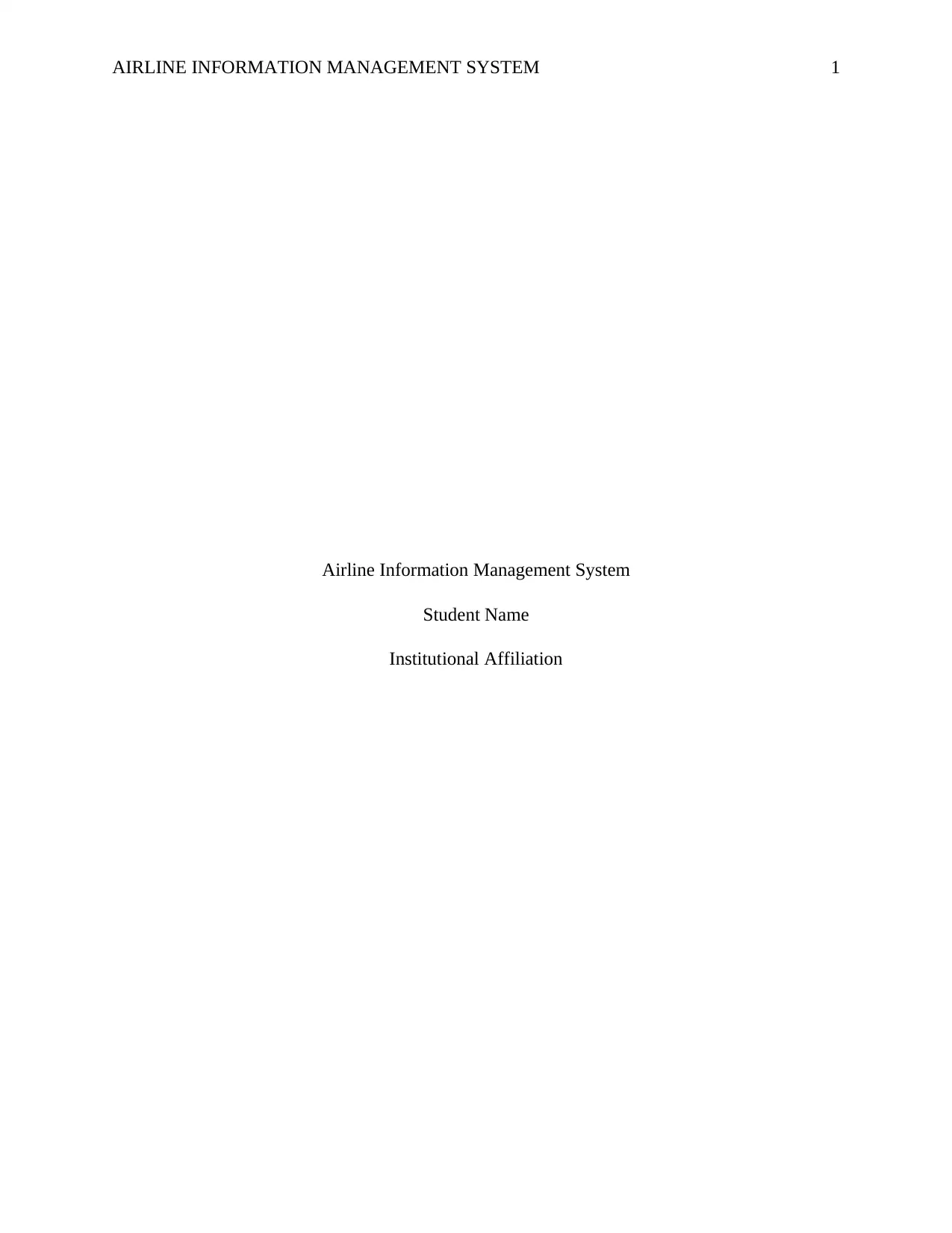
AIRLINE INFORMATION MANAGEMENT SYSTEM 1
Airline Information Management System
Student Name
Institutional Affiliation
Airline Information Management System
Student Name
Institutional Affiliation
Paraphrase This Document
Need a fresh take? Get an instant paraphrase of this document with our AI Paraphraser
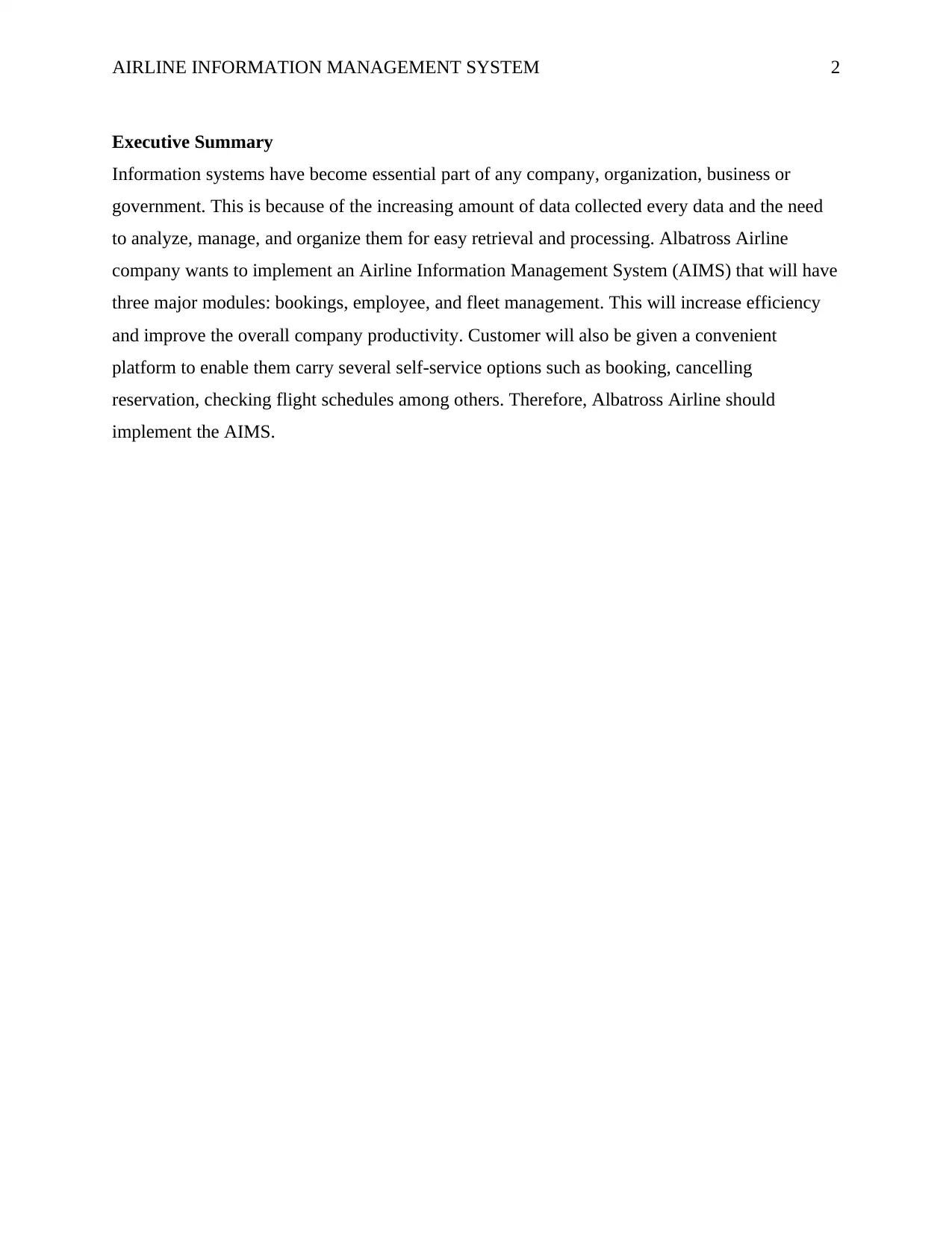
AIRLINE INFORMATION MANAGEMENT SYSTEM 2
Executive Summary
Information systems have become essential part of any company, organization, business or
government. This is because of the increasing amount of data collected every data and the need
to analyze, manage, and organize them for easy retrieval and processing. Albatross Airline
company wants to implement an Airline Information Management System (AIMS) that will have
three major modules: bookings, employee, and fleet management. This will increase efficiency
and improve the overall company productivity. Customer will also be given a convenient
platform to enable them carry several self-service options such as booking, cancelling
reservation, checking flight schedules among others. Therefore, Albatross Airline should
implement the AIMS.
Executive Summary
Information systems have become essential part of any company, organization, business or
government. This is because of the increasing amount of data collected every data and the need
to analyze, manage, and organize them for easy retrieval and processing. Albatross Airline
company wants to implement an Airline Information Management System (AIMS) that will have
three major modules: bookings, employee, and fleet management. This will increase efficiency
and improve the overall company productivity. Customer will also be given a convenient
platform to enable them carry several self-service options such as booking, cancelling
reservation, checking flight schedules among others. Therefore, Albatross Airline should
implement the AIMS.
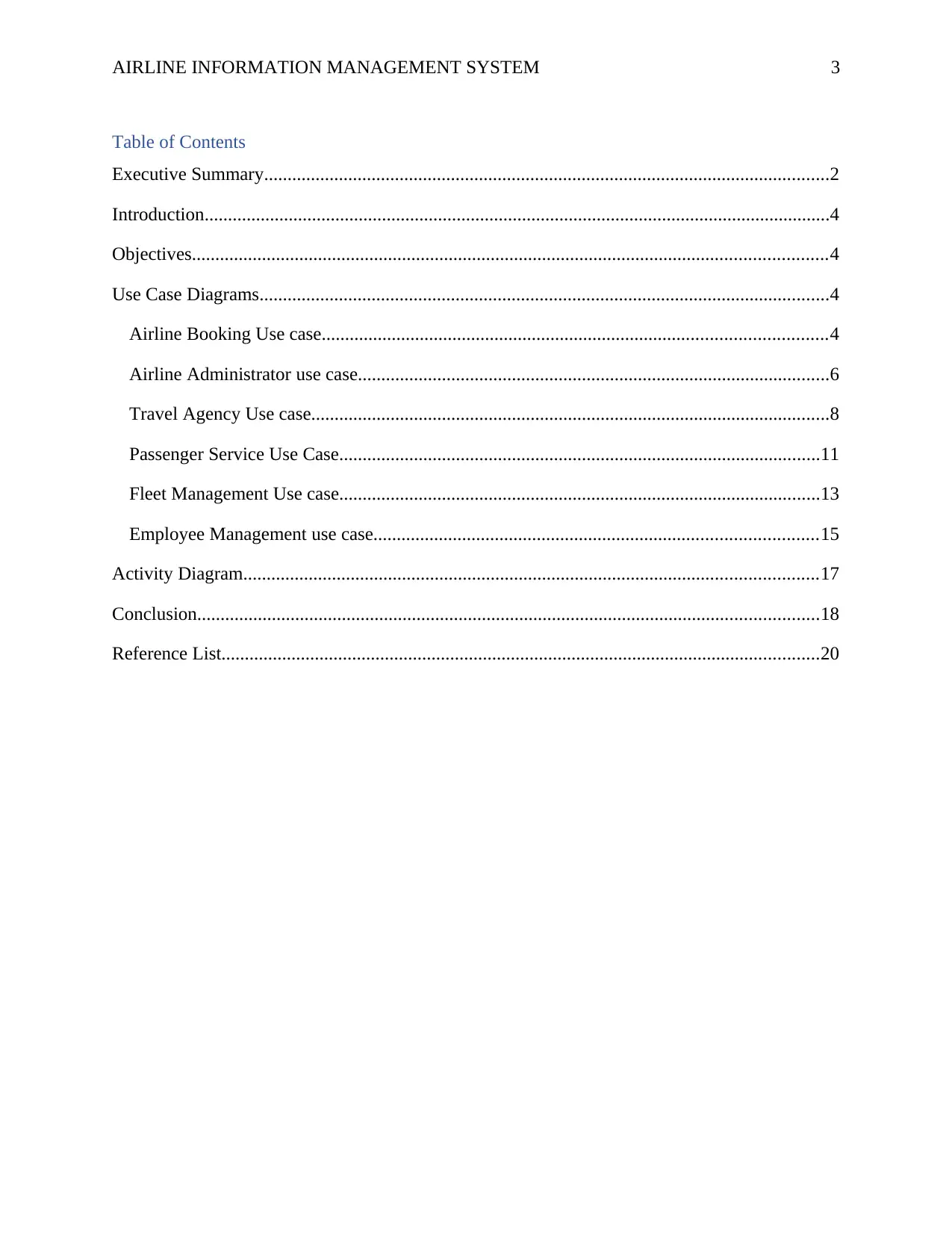
AIRLINE INFORMATION MANAGEMENT SYSTEM 3
Table of Contents
Executive Summary.........................................................................................................................2
Introduction......................................................................................................................................4
Objectives........................................................................................................................................4
Use Case Diagrams..........................................................................................................................4
Airline Booking Use case............................................................................................................4
Airline Administrator use case.....................................................................................................6
Travel Agency Use case...............................................................................................................8
Passenger Service Use Case.......................................................................................................11
Fleet Management Use case.......................................................................................................13
Employee Management use case...............................................................................................15
Activity Diagram...........................................................................................................................17
Conclusion.....................................................................................................................................18
Reference List................................................................................................................................20
Table of Contents
Executive Summary.........................................................................................................................2
Introduction......................................................................................................................................4
Objectives........................................................................................................................................4
Use Case Diagrams..........................................................................................................................4
Airline Booking Use case............................................................................................................4
Airline Administrator use case.....................................................................................................6
Travel Agency Use case...............................................................................................................8
Passenger Service Use Case.......................................................................................................11
Fleet Management Use case.......................................................................................................13
Employee Management use case...............................................................................................15
Activity Diagram...........................................................................................................................17
Conclusion.....................................................................................................................................18
Reference List................................................................................................................................20
⊘ This is a preview!⊘
Do you want full access?
Subscribe today to unlock all pages.

Trusted by 1+ million students worldwide
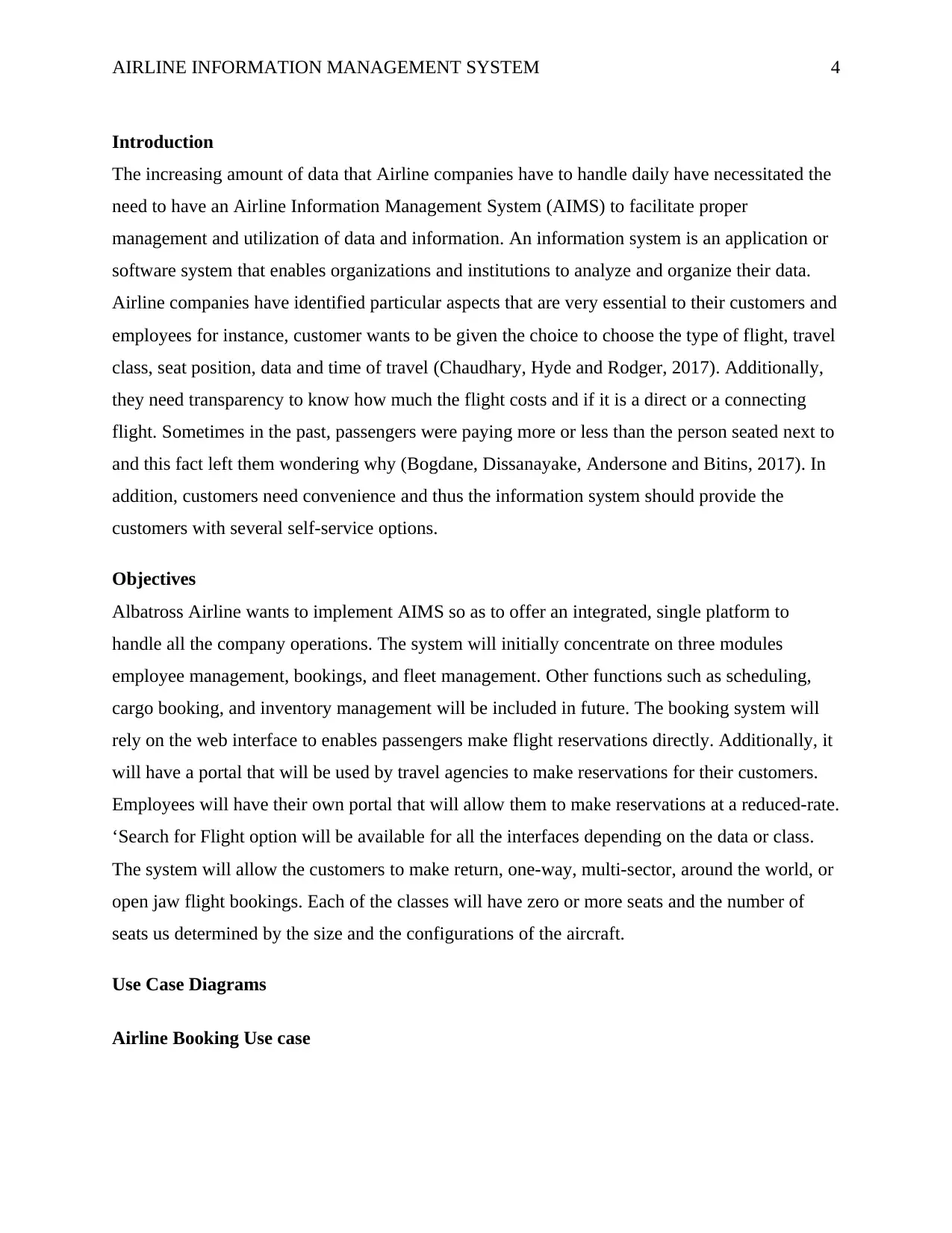
AIRLINE INFORMATION MANAGEMENT SYSTEM 4
Introduction
The increasing amount of data that Airline companies have to handle daily have necessitated the
need to have an Airline Information Management System (AIMS) to facilitate proper
management and utilization of data and information. An information system is an application or
software system that enables organizations and institutions to analyze and organize their data.
Airline companies have identified particular aspects that are very essential to their customers and
employees for instance, customer wants to be given the choice to choose the type of flight, travel
class, seat position, data and time of travel (Chaudhary, Hyde and Rodger, 2017). Additionally,
they need transparency to know how much the flight costs and if it is a direct or a connecting
flight. Sometimes in the past, passengers were paying more or less than the person seated next to
and this fact left them wondering why (Bogdane, Dissanayake, Andersone and Bitins, 2017). In
addition, customers need convenience and thus the information system should provide the
customers with several self-service options.
Objectives
Albatross Airline wants to implement AIMS so as to offer an integrated, single platform to
handle all the company operations. The system will initially concentrate on three modules
employee management, bookings, and fleet management. Other functions such as scheduling,
cargo booking, and inventory management will be included in future. The booking system will
rely on the web interface to enables passengers make flight reservations directly. Additionally, it
will have a portal that will be used by travel agencies to make reservations for their customers.
Employees will have their own portal that will allow them to make reservations at a reduced-rate.
‘Search for Flight option will be available for all the interfaces depending on the data or class.
The system will allow the customers to make return, one-way, multi-sector, around the world, or
open jaw flight bookings. Each of the classes will have zero or more seats and the number of
seats us determined by the size and the configurations of the aircraft.
Use Case Diagrams
Airline Booking Use case
Introduction
The increasing amount of data that Airline companies have to handle daily have necessitated the
need to have an Airline Information Management System (AIMS) to facilitate proper
management and utilization of data and information. An information system is an application or
software system that enables organizations and institutions to analyze and organize their data.
Airline companies have identified particular aspects that are very essential to their customers and
employees for instance, customer wants to be given the choice to choose the type of flight, travel
class, seat position, data and time of travel (Chaudhary, Hyde and Rodger, 2017). Additionally,
they need transparency to know how much the flight costs and if it is a direct or a connecting
flight. Sometimes in the past, passengers were paying more or less than the person seated next to
and this fact left them wondering why (Bogdane, Dissanayake, Andersone and Bitins, 2017). In
addition, customers need convenience and thus the information system should provide the
customers with several self-service options.
Objectives
Albatross Airline wants to implement AIMS so as to offer an integrated, single platform to
handle all the company operations. The system will initially concentrate on three modules
employee management, bookings, and fleet management. Other functions such as scheduling,
cargo booking, and inventory management will be included in future. The booking system will
rely on the web interface to enables passengers make flight reservations directly. Additionally, it
will have a portal that will be used by travel agencies to make reservations for their customers.
Employees will have their own portal that will allow them to make reservations at a reduced-rate.
‘Search for Flight option will be available for all the interfaces depending on the data or class.
The system will allow the customers to make return, one-way, multi-sector, around the world, or
open jaw flight bookings. Each of the classes will have zero or more seats and the number of
seats us determined by the size and the configurations of the aircraft.
Use Case Diagrams
Airline Booking Use case
Paraphrase This Document
Need a fresh take? Get an instant paraphrase of this document with our AI Paraphraser

AIRLINE INFORMATION MANAGEMENT SYSTEM 5
Figure 1: Comprehensive Booking Use case
(Source: Llach, Marimon, Alonso-Almeida and Bernardo, 2013)
Description
Name: Airline Booking
Identifier: AB
Description: The use case diagram above shows the actors that interact with the booking system.
The traveler (can be an employee or customer) can be able to make online enquiries, book ticket
online, cancel the reservation, check the status of the reservation and booking details. The
traveler can also use the travel agency to make their bookings. The administrator can make
changes to the reservation details upon request by the traveler or travel agency on behalf of the
client (Llach, Marimon, Alonso-Almeida and Bernardo, 2013).
Figure 1: Comprehensive Booking Use case
(Source: Llach, Marimon, Alonso-Almeida and Bernardo, 2013)
Description
Name: Airline Booking
Identifier: AB
Description: The use case diagram above shows the actors that interact with the booking system.
The traveler (can be an employee or customer) can be able to make online enquiries, book ticket
online, cancel the reservation, check the status of the reservation and booking details. The
traveler can also use the travel agency to make their bookings. The administrator can make
changes to the reservation details upon request by the traveler or travel agency on behalf of the
client (Llach, Marimon, Alonso-Almeida and Bernardo, 2013).
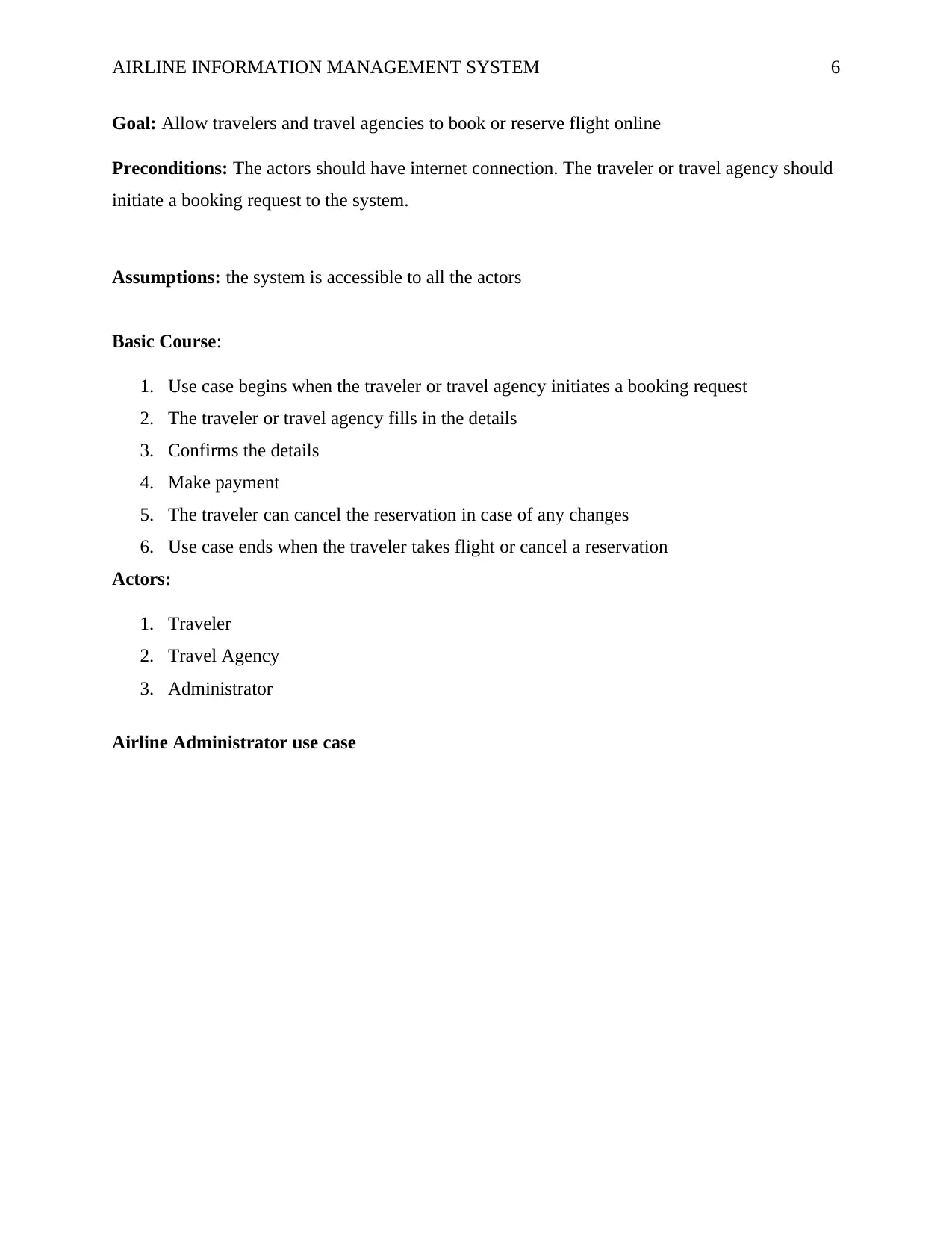
AIRLINE INFORMATION MANAGEMENT SYSTEM 6
Goal: Allow travelers and travel agencies to book or reserve flight online
Preconditions: The actors should have internet connection. The traveler or travel agency should
initiate a booking request to the system.
Assumptions: the system is accessible to all the actors
Basic Course:
1. Use case begins when the traveler or travel agency initiates a booking request
2. The traveler or travel agency fills in the details
3. Confirms the details
4. Make payment
5. The traveler can cancel the reservation in case of any changes
6. Use case ends when the traveler takes flight or cancel a reservation
Actors:
1. Traveler
2. Travel Agency
3. Administrator
Airline Administrator use case
Goal: Allow travelers and travel agencies to book or reserve flight online
Preconditions: The actors should have internet connection. The traveler or travel agency should
initiate a booking request to the system.
Assumptions: the system is accessible to all the actors
Basic Course:
1. Use case begins when the traveler or travel agency initiates a booking request
2. The traveler or travel agency fills in the details
3. Confirms the details
4. Make payment
5. The traveler can cancel the reservation in case of any changes
6. Use case ends when the traveler takes flight or cancel a reservation
Actors:
1. Traveler
2. Travel Agency
3. Administrator
Airline Administrator use case
⊘ This is a preview!⊘
Do you want full access?
Subscribe today to unlock all pages.

Trusted by 1+ million students worldwide
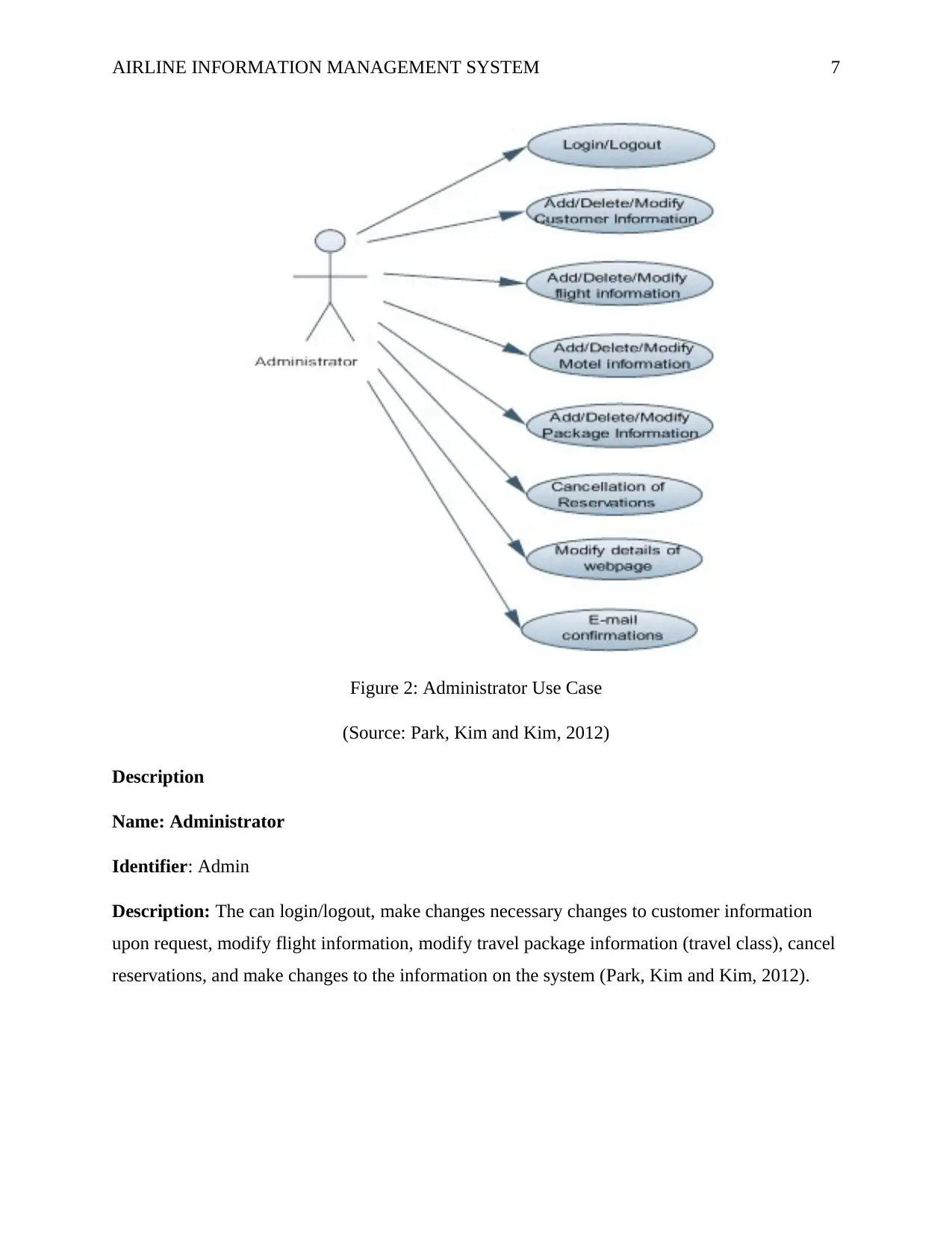
AIRLINE INFORMATION MANAGEMENT SYSTEM 7
Figure 2: Administrator Use Case
(Source: Park, Kim and Kim, 2012)
Description
Name: Administrator
Identifier: Admin
Description: The can login/logout, make changes necessary changes to customer information
upon request, modify flight information, modify travel package information (travel class), cancel
reservations, and make changes to the information on the system (Park, Kim and Kim, 2012).
Figure 2: Administrator Use Case
(Source: Park, Kim and Kim, 2012)
Description
Name: Administrator
Identifier: Admin
Description: The can login/logout, make changes necessary changes to customer information
upon request, modify flight information, modify travel package information (travel class), cancel
reservations, and make changes to the information on the system (Park, Kim and Kim, 2012).
Paraphrase This Document
Need a fresh take? Get an instant paraphrase of this document with our AI Paraphraser
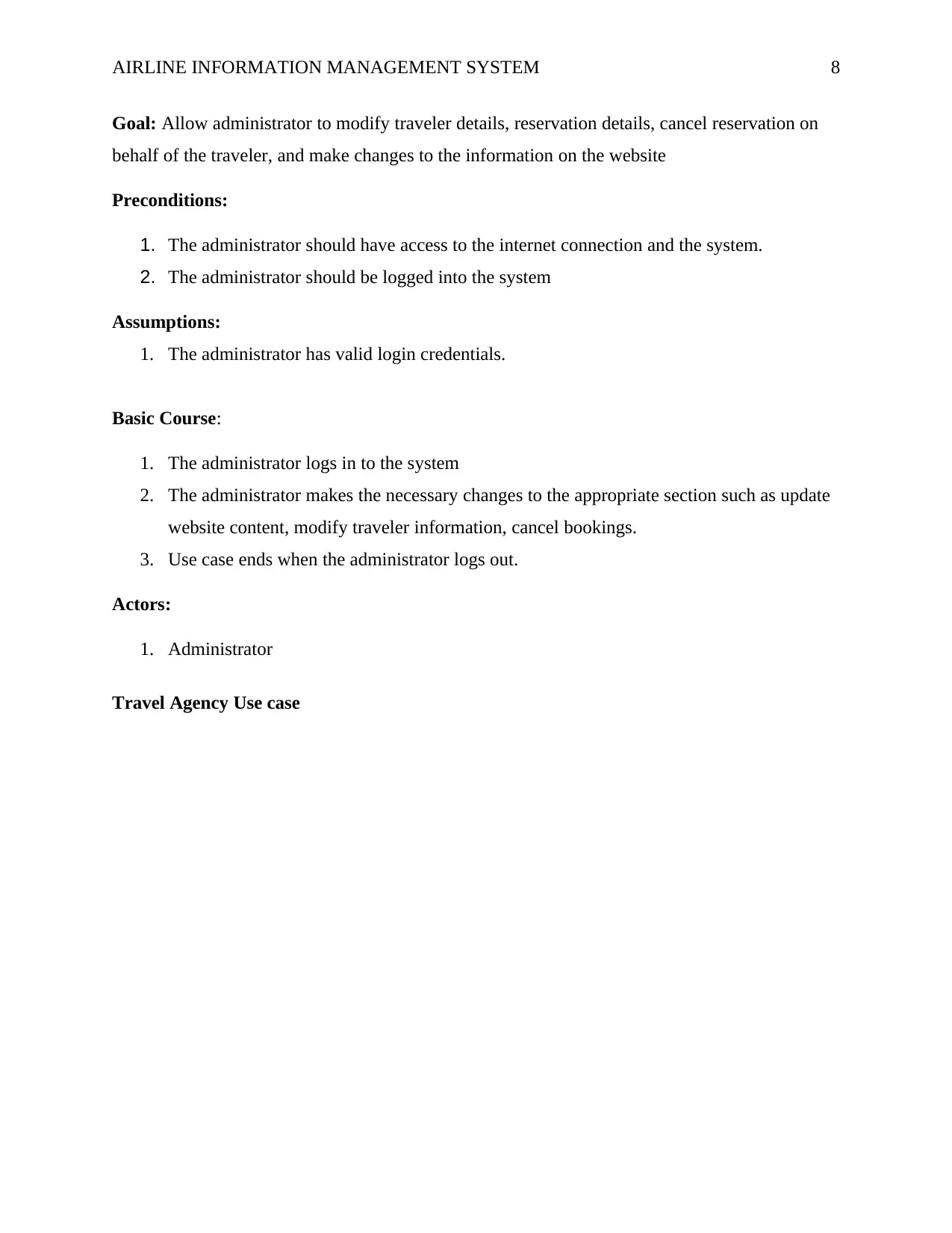
AIRLINE INFORMATION MANAGEMENT SYSTEM 8
Goal: Allow administrator to modify traveler details, reservation details, cancel reservation on
behalf of the traveler, and make changes to the information on the website
Preconditions:
1. The administrator should have access to the internet connection and the system.
2. The administrator should be logged into the system
Assumptions:
1. The administrator has valid login credentials.
Basic Course:
1. The administrator logs in to the system
2. The administrator makes the necessary changes to the appropriate section such as update
website content, modify traveler information, cancel bookings.
3. Use case ends when the administrator logs out.
Actors:
1. Administrator
Travel Agency Use case
Goal: Allow administrator to modify traveler details, reservation details, cancel reservation on
behalf of the traveler, and make changes to the information on the website
Preconditions:
1. The administrator should have access to the internet connection and the system.
2. The administrator should be logged into the system
Assumptions:
1. The administrator has valid login credentials.
Basic Course:
1. The administrator logs in to the system
2. The administrator makes the necessary changes to the appropriate section such as update
website content, modify traveler information, cancel bookings.
3. Use case ends when the administrator logs out.
Actors:
1. Administrator
Travel Agency Use case
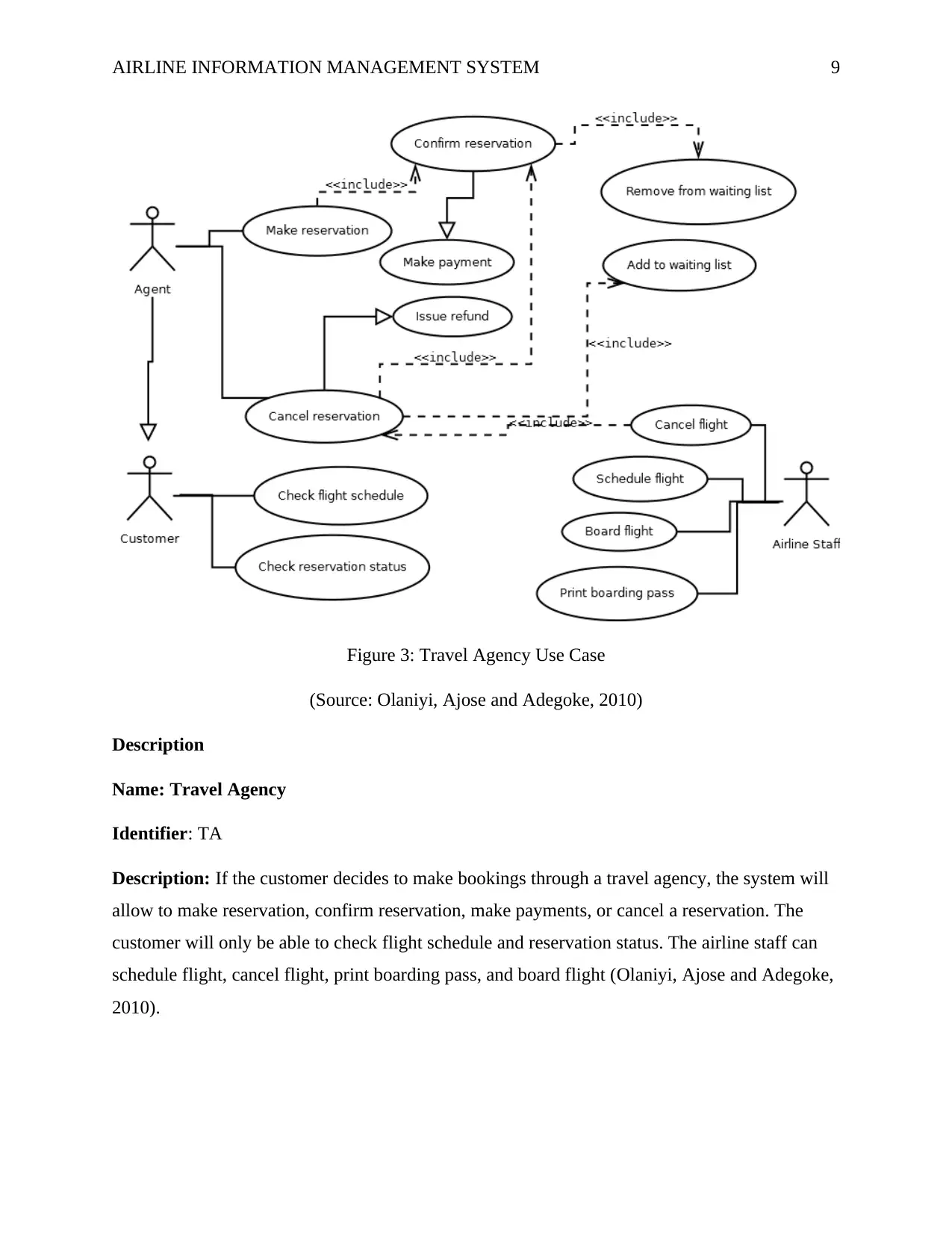
AIRLINE INFORMATION MANAGEMENT SYSTEM 9
Figure 3: Travel Agency Use Case
(Source: Olaniyi, Ajose and Adegoke, 2010)
Description
Name: Travel Agency
Identifier: TA
Description: If the customer decides to make bookings through a travel agency, the system will
allow to make reservation, confirm reservation, make payments, or cancel a reservation. The
customer will only be able to check flight schedule and reservation status. The airline staff can
schedule flight, cancel flight, print boarding pass, and board flight (Olaniyi, Ajose and Adegoke,
2010).
Figure 3: Travel Agency Use Case
(Source: Olaniyi, Ajose and Adegoke, 2010)
Description
Name: Travel Agency
Identifier: TA
Description: If the customer decides to make bookings through a travel agency, the system will
allow to make reservation, confirm reservation, make payments, or cancel a reservation. The
customer will only be able to check flight schedule and reservation status. The airline staff can
schedule flight, cancel flight, print boarding pass, and board flight (Olaniyi, Ajose and Adegoke,
2010).
⊘ This is a preview!⊘
Do you want full access?
Subscribe today to unlock all pages.

Trusted by 1+ million students worldwide
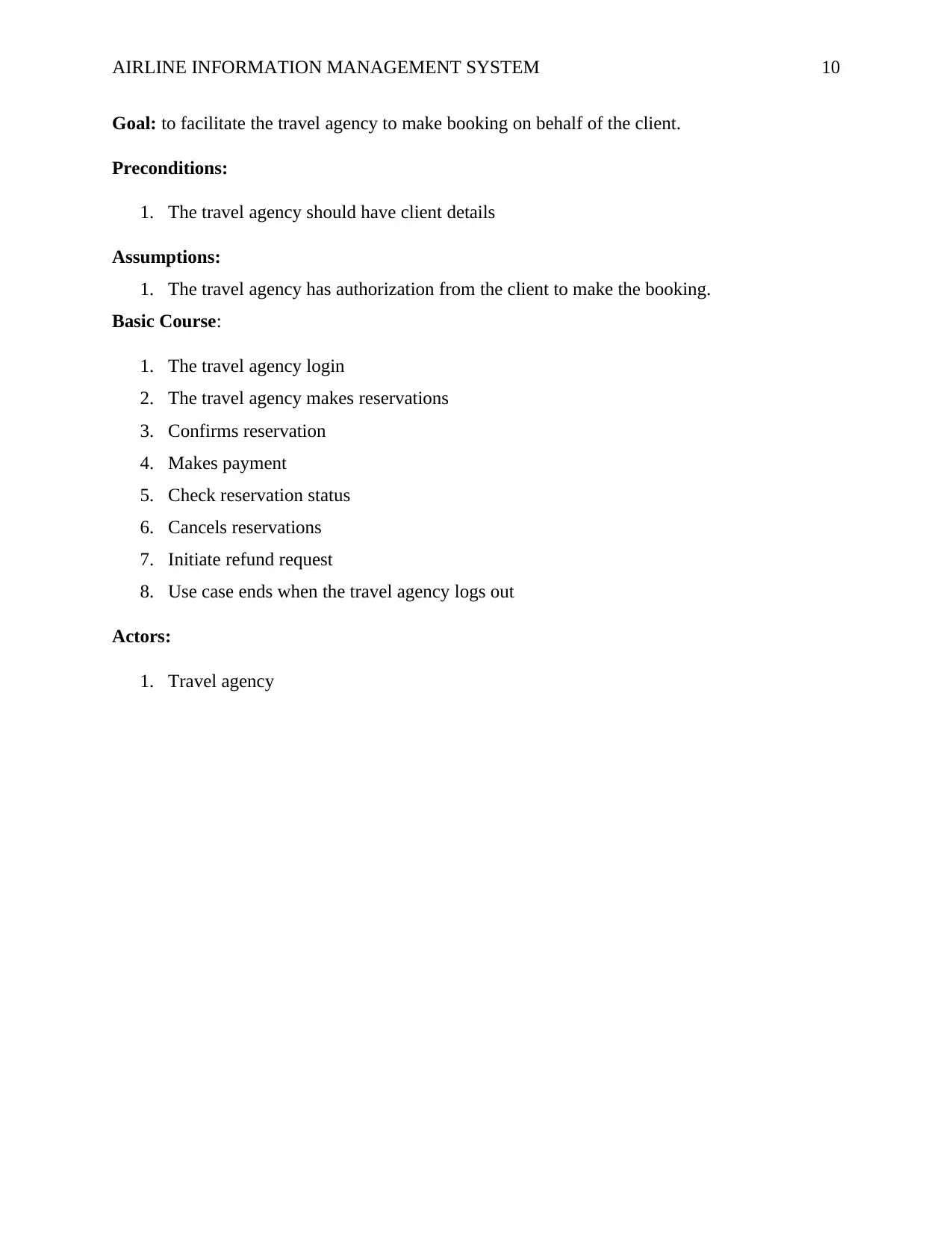
AIRLINE INFORMATION MANAGEMENT SYSTEM 10
Goal: to facilitate the travel agency to make booking on behalf of the client.
Preconditions:
1. The travel agency should have client details
Assumptions:
1. The travel agency has authorization from the client to make the booking.
Basic Course:
1. The travel agency login
2. The travel agency makes reservations
3. Confirms reservation
4. Makes payment
5. Check reservation status
6. Cancels reservations
7. Initiate refund request
8. Use case ends when the travel agency logs out
Actors:
1. Travel agency
Goal: to facilitate the travel agency to make booking on behalf of the client.
Preconditions:
1. The travel agency should have client details
Assumptions:
1. The travel agency has authorization from the client to make the booking.
Basic Course:
1. The travel agency login
2. The travel agency makes reservations
3. Confirms reservation
4. Makes payment
5. Check reservation status
6. Cancels reservations
7. Initiate refund request
8. Use case ends when the travel agency logs out
Actors:
1. Travel agency
Paraphrase This Document
Need a fresh take? Get an instant paraphrase of this document with our AI Paraphraser
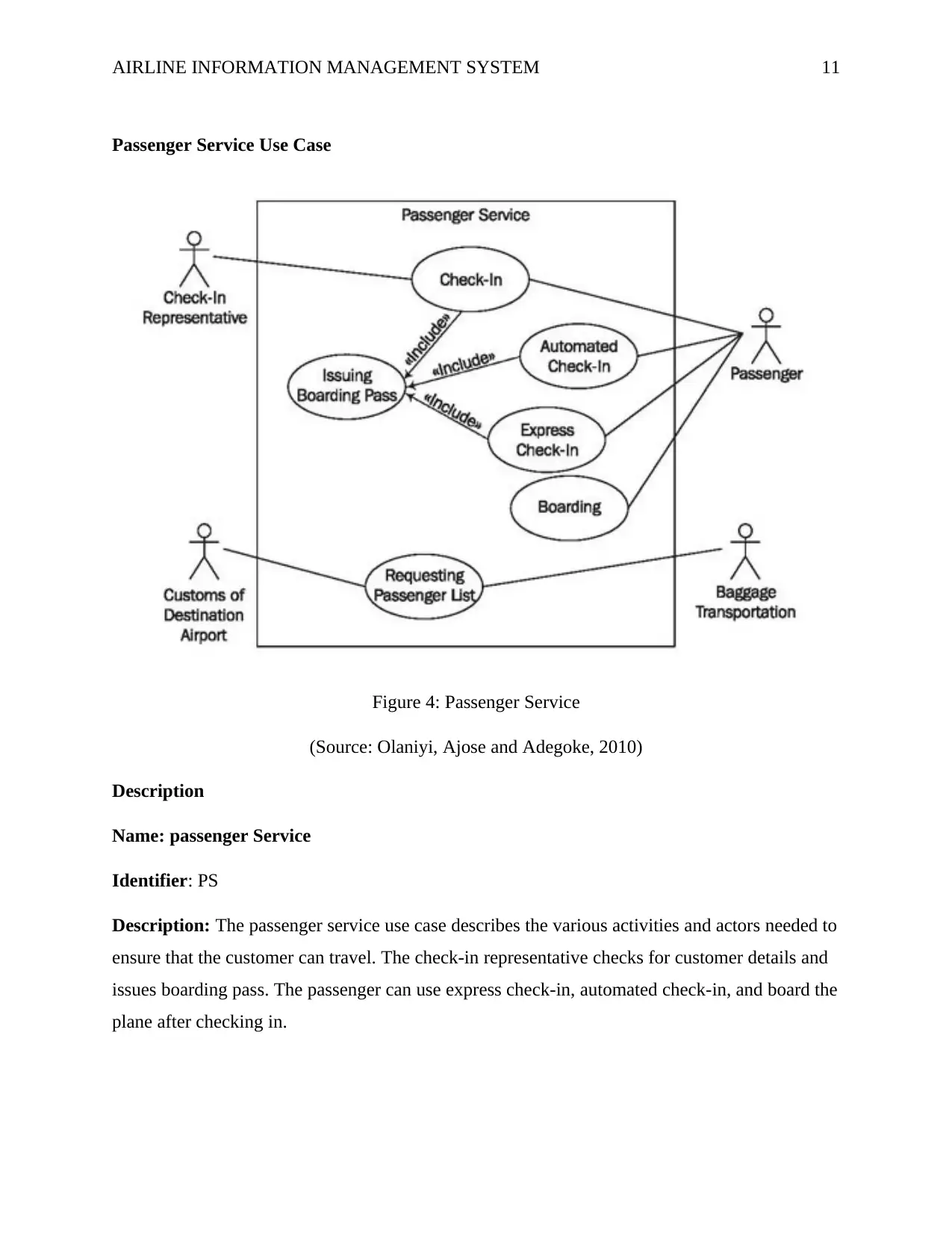
AIRLINE INFORMATION MANAGEMENT SYSTEM 11
Passenger Service Use Case
Figure 4: Passenger Service
(Source: Olaniyi, Ajose and Adegoke, 2010)
Description
Name: passenger Service
Identifier: PS
Description: The passenger service use case describes the various activities and actors needed to
ensure that the customer can travel. The check-in representative checks for customer details and
issues boarding pass. The passenger can use express check-in, automated check-in, and board the
plane after checking in.
Passenger Service Use Case
Figure 4: Passenger Service
(Source: Olaniyi, Ajose and Adegoke, 2010)
Description
Name: passenger Service
Identifier: PS
Description: The passenger service use case describes the various activities and actors needed to
ensure that the customer can travel. The check-in representative checks for customer details and
issues boarding pass. The passenger can use express check-in, automated check-in, and board the
plane after checking in.

AIRLINE INFORMATION MANAGEMENT SYSTEM 12
Goal: to facilitate the traveler to check in and board the flight.
Preconditions:
1. The traveler should be at the airport check in desk
Assumptions:
1. The traveler has been issued with a boarding ticket.
Basic Course:
1. The traveler automatically checks in or use express check in
2. The check in representative issue the traveler with boarding pass
3. The customs of destination airport and the luggage transportation are issued with
passenger list
4. Use case ends when the traveler boards the plane
Actors:
1. Passenger
2. Check-in representative
3. Baggage transportation
4. Custom of the destination airport
Goal: to facilitate the traveler to check in and board the flight.
Preconditions:
1. The traveler should be at the airport check in desk
Assumptions:
1. The traveler has been issued with a boarding ticket.
Basic Course:
1. The traveler automatically checks in or use express check in
2. The check in representative issue the traveler with boarding pass
3. The customs of destination airport and the luggage transportation are issued with
passenger list
4. Use case ends when the traveler boards the plane
Actors:
1. Passenger
2. Check-in representative
3. Baggage transportation
4. Custom of the destination airport
⊘ This is a preview!⊘
Do you want full access?
Subscribe today to unlock all pages.

Trusted by 1+ million students worldwide
1 out of 20
Related Documents
Your All-in-One AI-Powered Toolkit for Academic Success.
+13062052269
info@desklib.com
Available 24*7 on WhatsApp / Email
![[object Object]](/_next/static/media/star-bottom.7253800d.svg)
Unlock your academic potential
Copyright © 2020–2025 A2Z Services. All Rights Reserved. Developed and managed by ZUCOL.





